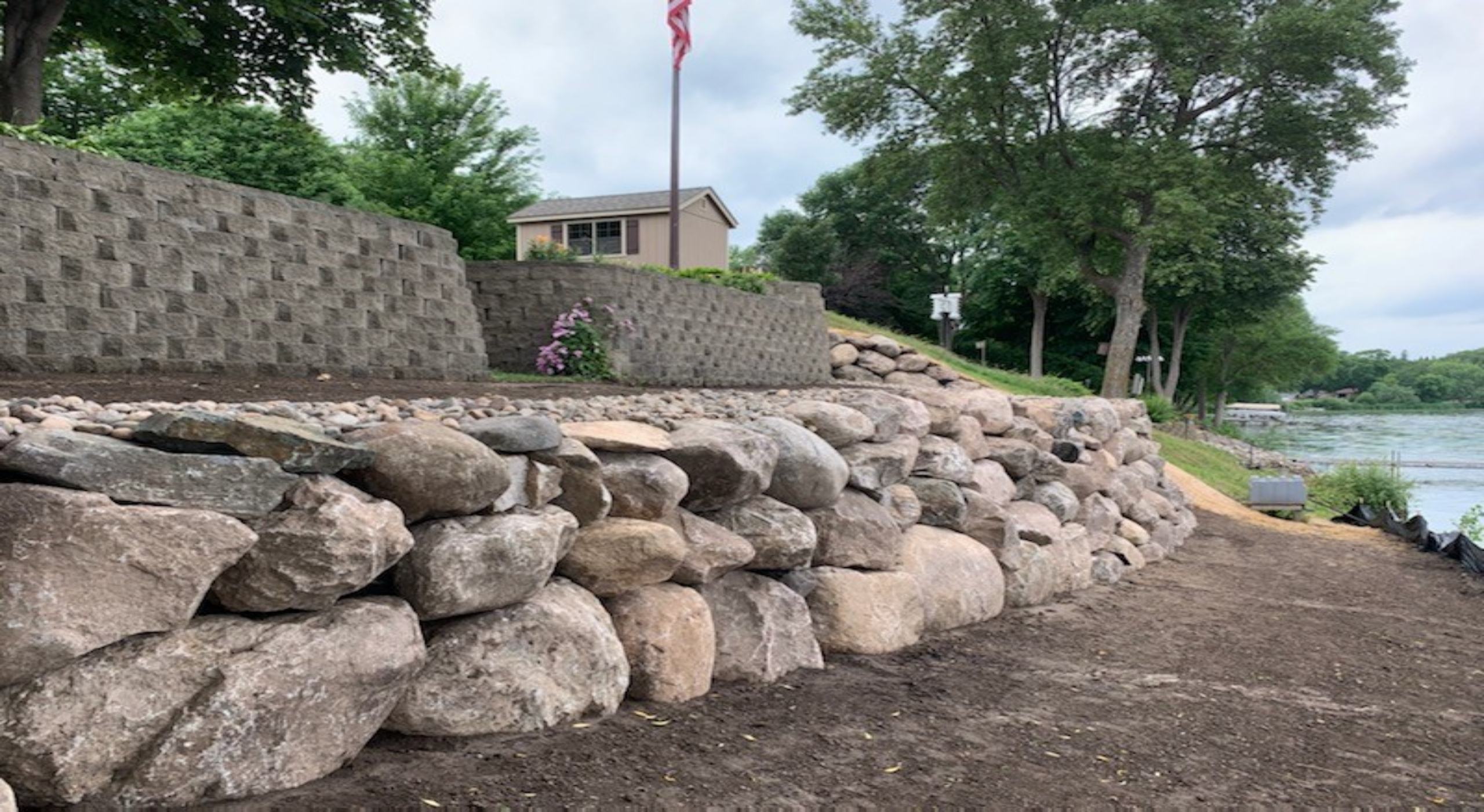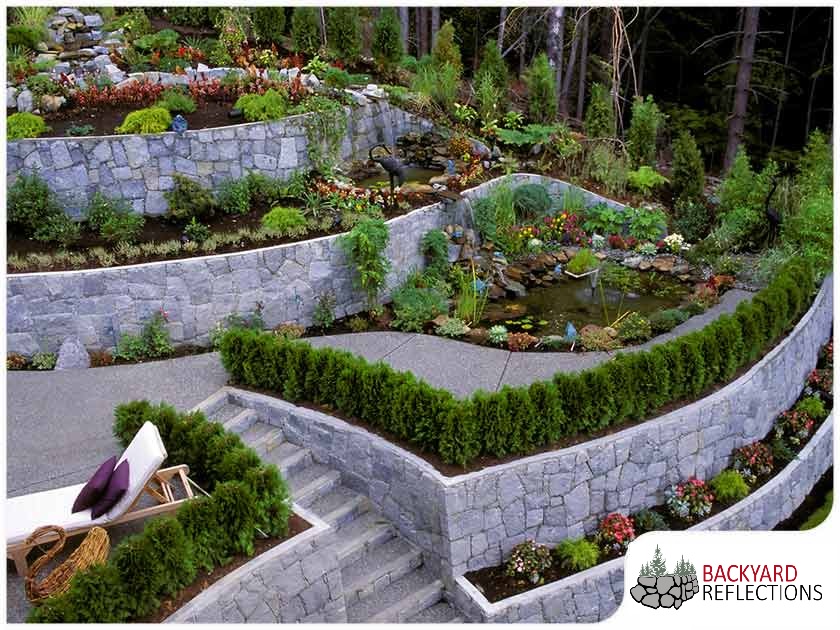Key Considerations for Structure Reliable Retaining Walls in Your Lawn
When you're considering constructing a preserving wall in your lawn, it's essential to think of a number of essential elements. The wall's function, the materials you'll make use of, and the details soil problems can all impact its performance and long life. You'll additionally need to navigate local building codes and prepare for proper drain. Yet exactly how do you ensure your style not just meets these requirements but additionally enhances your landscape? Allow's discover the crucial actions with each other.
Understanding the Purpose of Your Retaining Wall
When you think of constructing a retaining wall surface, consider its main function: stabilizing soil and stopping disintegration. Retaining walls provide essential assistance for sloped landscapes, aiding to keep dirt honesty. You'll locate they're important in locations where water drainage might or else clean away dirt, causing pricey repairs and landscape damage.
By holding back planet, these walls create level surface areas for gardens, outdoor patios, or pathways. This not just enhances your lawn's appearances yet likewise promotes much better drain, minimizing water merging in undesirable areas. If you're managing steep slopes, a sound retaining wall can stop landslides, ensuring safety and security for you and your residential or commercial property.
Inevitably, comprehending the objective of your retaining wall surface will guide your layout choices and help you produce a functional, sturdy framework that satisfies your needs. Take a minute to review your landscape; it'll pay off in the long run.
Selecting the Right Materials
When picking materials for your retaining wall, you'll desire to take into consideration longevity, visual appeals, and cost. Each factor plays an essential function in ensuring your wall surface stands the test of time while looking terrific and suitable your spending plan. Let's discover exactly how to make the best choices for your job.
Material Sturdiness Elements
Picking the best products is essential for the durability and performance of your retaining wall surface, since their sturdiness straight affects the wall's capability to hold up against environmental stress and anxieties. Start by considering your local climate; materials like concrete and stone withstand dampness and temperature level changes well. If you stay in an area prone to heavy rainfalls, choose materials with great drain properties, like gravel or porous blocks, to avoid water buildup.
In addition, think of the soil conditions on your property. Some products execute much better in specific soil kinds, so it is necessary to match them as necessary. Be conscious of potential wear from bugs or disintegration. Selecting long lasting materials guarantees your retaining wall surface stands solid, securing your yard for years to find.
Aesthetic Layout Selections
Durable materials not just ensure your retaining wall surface's structural stability but also play a key role in its aesthetic appeal. Don't neglect about the wall's shape-- rounded walls can produce a softer appearance, while straight lines can really feel much more structured. By meticulously choosing products that align with your visual vision, you'll boost your outdoor area while ensuring your wall stands solid against the elements.
Cost-Effectiveness Analysis
Choosing the right materials for your retaining wall surface isn't simply regarding appearances; it's additionally necessary for your spending plan. When picking materials, take into consideration both ahead of time expenses and long-lasting resilience.
Do not neglect to consider maintenance expenses too (OKC Precision Retaining Walls). Some products, like all-natural stone, can include charm and require much less upkeep, while others could require normal therapies
Inevitably, weigh the pros and disadvantages of each option against your budget and the wall's desired function. Investing carefully in materials currently can prevent pricey issues down the roadway. Pick products that balance cost and efficiency effectively.
Evaluating Dirt Problems and Water Drainage
As you begin your project, assessing dirt problems and drainage is crucial for the success of your retaining wall. Sandy dirt drains pipes well yet lacks stability, while clay soil can preserve wetness, leading to press on your wall surface.
Following, analyze the incline of your lawn. If water naturally flows towards your wall, you'll need to implement a drainage service to stop disintegration and pressure build-up. Think about installing perforated pipelines or crushed rock backfill behind the wall to facilitate drain.
Lastly, observe any kind of nearby trees or plant life; their roots can affect soil security. By understanding your dirt problems and carrying out correct drain, you'll create a strong foundation for your retaining wall that stands the examination of time.
Following Local Building Ordinance
Prior to you start constructing your retaining wall, you require to research local guidelines to assure compliance. It's important to comprehend what allows you need to obtain, as this can save you from expensive penalties or having to renovate your work. Taking these actions seriously will help you develop a risk-free and reliable framework.
Research Local Laws
Recognizing local policies is important when Continue planning your retaining wall surface project, particularly given that building codes can differ significantly by location. Start by consulting your local structure department or district to find out about certain needs. Seek standards on wall surface elevation, products, drainage systems, and structural stability. Lots of areas have restrictions on the kinds of products you can utilize and how high you can build. You'll also intend to take into consideration the zoning regulations that may impact your project. Disregarding these regulations can bring about expensive fines or the requirement to redo your job. By doing your research study upfront, you can guarantee your retaining wall surface satisfies all necessary codes and blends flawlessly into your backyard.
Get Necessary Permits
As soon as you've researched local laws, the next step is to acquire the required licenses for your retaining wall job. They may need details plans or engineering assessments, specifically for larger walls. Securing the ideal authorizations can conserve you from expensive penalties or having to dismantle your wall later on.

Planning the Layout and Aesthetic Appeal
As you begin intending the design and aesthetic appeals of your retaining wall surface, think about just how it will certainly balance with the surrounding landscape. Assume regarding the products you'll make use of-- stone, block, or concrete-- and exactly how they'll enhance your home's design and the natural elements in your lawn. Pick shades and textures that blend effortlessly with existing functions click over here like patios, pathways, or gardens.
Following, visualize the wall's shape and elevation. Curved walls can soften a rigid landscape, while straight lines might communicate a more contemporary look. Don't forget to integrate plants and greenery around the wall surface for a natural touch; this can improve its appeal and incorporate it right into the atmosphere.
Last but not least, keep in mind capability. Your style needs to not only be aesthetically pleasing but additionally offer its objective successfully. By attentively preparing these components, you'll create a preserving wall that enhances your backyard's beauty while satisfying its architectural role.
Determining Elevation and Thickness Demands
To build a strong retaining wall surface, you need to precisely compute its height and thickness demands based upon the dirt conditions and the elevation of the incline it will support. Begin by reviewing the slope's angle and the kind of dirt, as different soils put in differing quantities of pressure.
For walls over four feet high, think about a density of a minimum of 12 inches. If the wall is taller, raise the thickness proportionally to maintain security.
Next, compute the elevation of the wall surface by gauging the vertical distance it needs to keep. For each foot of elevation, you need to normally prepare for a density of one-third of the wall's elevation.
Constantly bear in mind to account for additional elements like drain and backfill, which can affect your wall surface's layout. Correct computations currently ensure your retaining wall surface stands strong and lasts for many years to find.
Maintenance and Durability Factors To Consider
While preserving your retaining wall surface could look like a reduced concern, overlooking it can cause considerable problems over time. Routine inspections are important; check for cracks, protrudes, or any signs of water damages. Resolving these issues early can save you from costly repairs later on.
Maintain an eye on drain systems, also. Blocked drains pipes can create water to develop, applying pressure on your wall surface and compromising its security. Clear debris and guarantee correct flow to keep long life.
You may additionally desire to show on sealing your wall surface to safeguard it from dampness and weathering. Depending upon the material, this might need reapplication every few years.
Last but not least, landscaping around your wall surface can support its integrity. Avoid growing large trees close by, as their roots can undermine the structure. With proactive upkeep, your retaining wall can offer you well this content for several years ahead.

Often Asked Inquiries
Can I Develop a Retaining Wall by Myself, or Should I Work with an Expert?
You can definitely build a preserving wall on your own if you have the right devices and knowledge. Working with an expert assurances it's done appropriately, particularly for larger or more complex structures. Consider your ability level before making a decision.
What Are one of the most Usual Errors Made When Building Retaining Walls?
When developing retaining walls, you may forget appropriate drain, miss making use of the right materials, or overlook support. These usual mistakes can lead to structural failing, so take your time and strategy meticulously to stay clear of concerns.
How Do I Know if My Retaining Wall Needs Reinforcement?
You'll know your retaining wall needs reinforcement if you notice cracks, leaning, or bulging. Examine for water merging behind it or dirt disintegration near the base. Address these indications promptly to stop further damage.
What Plants Appropriate for Landscaping Around a Retaining Wall?
When landscape design around a maintaining wall, take into consideration making use of low-maintenance plants like succulents, decorative lawns, or sneaking ground covers - OKC Precision Retaining Walls. They'll flourish in those conditions and add elegance while avoiding soil erosion around your wall
How Can I Protect Against Disintegration Around My Retaining Wall?
To protect against erosion around your retaining wall surface, you can grow ground cover, use compost, and install drainage systems. On a regular basis inspect for water accumulation and adjust landscape design to reroute overflow away from the wall surface.